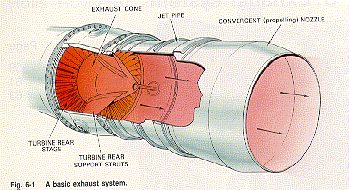Nozzle
The nozzle serves to convert any energy remaining in the flow (after the turbine) to kinetic energy by decreasing pressure and accelerating the flow. This results in thrust.
The nozzle design is very important because it determines the turbine entry temperature (and hence the work done by the turbine) as well as the mass flow of the engine and the exit velocity and pressure (all four of which determine thrust).
 The most basic nozzle consists simply of a duct. The air exiting the turbine is often traveling greater than Mach 1, but this creates high friction losses, so the flow is immediately slowed by diffusion. The whirl of the turbine exit flow is reduced by the turbine rear support struts, which turn the flow straight. This straight, high-pressure flow is fed to a converging section, which changes the pressure back to velocity. This flow is often choked; i.e. the exit velocity cannot be increased. However, the exit pressure can be increased, resulting in pressure thrust.
The most basic nozzle consists simply of a duct. The air exiting the turbine is often traveling greater than Mach 1, but this creates high friction losses, so the flow is immediately slowed by diffusion. The whirl of the turbine exit flow is reduced by the turbine rear support struts, which turn the flow straight. This straight, high-pressure flow is fed to a converging section, which changes the pressure back to velocity. This flow is often choked; i.e. the exit velocity cannot be increased. However, the exit pressure can be increased, resulting in pressure thrust.
For some flight plans, it is possible to use a convergent/divergent duct, which takes the flow past its choke point and increases the exit velocity further. This is a more efficient use of the flow's energy than pressure thrust. This is sometimes seen on engines with a very high pressure ratio.
Due to the wide range of operating conditions some engines must endure, sometimes it is advantageous to have an adjustable nozzle. Most often this is seen on engines with afterburners as they must face a very wide range of conditions.
The nozzle must withstand high heat and pressure. It must be insulated from the rest of the aircraft, either with a short section of insulation, or by isolating the jet pipe from the aircraft. The nozzle is often cooled by flow around the outside, using a variety of methods. The nozzle as a whole must be able to expand and contract with temperature, without damage or distortion.


